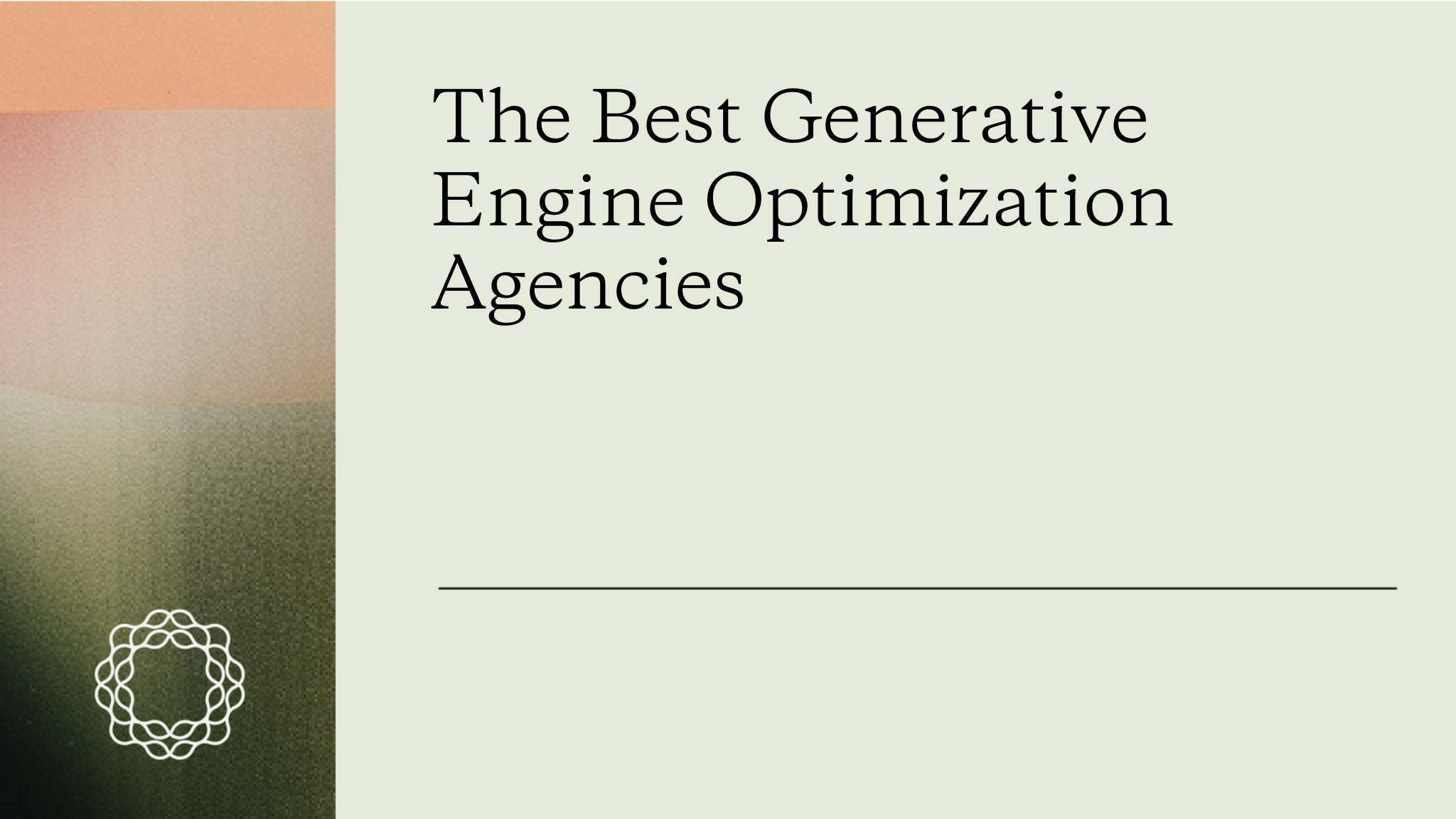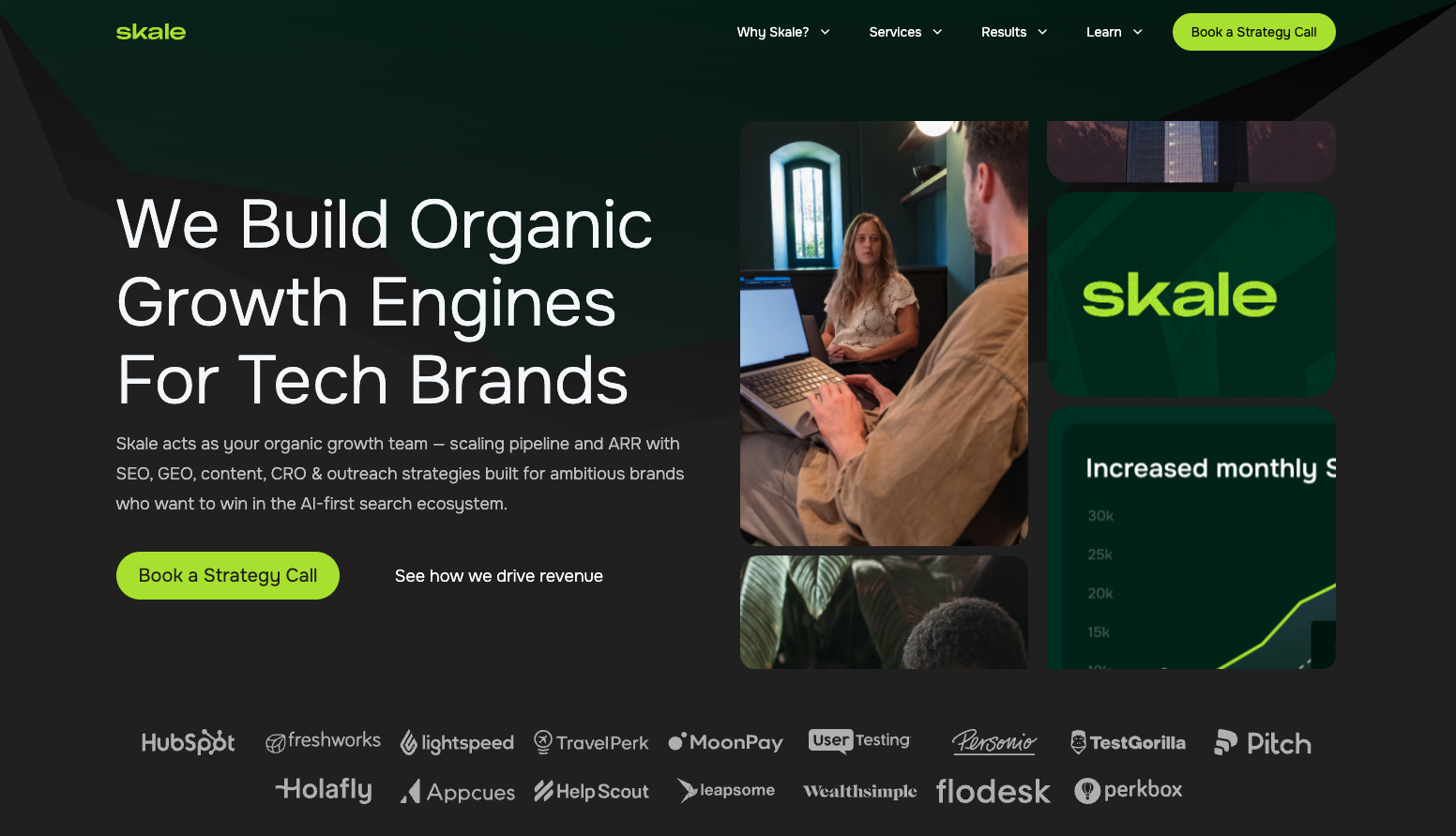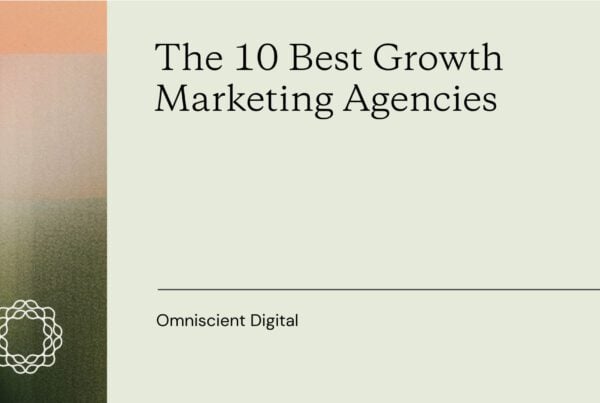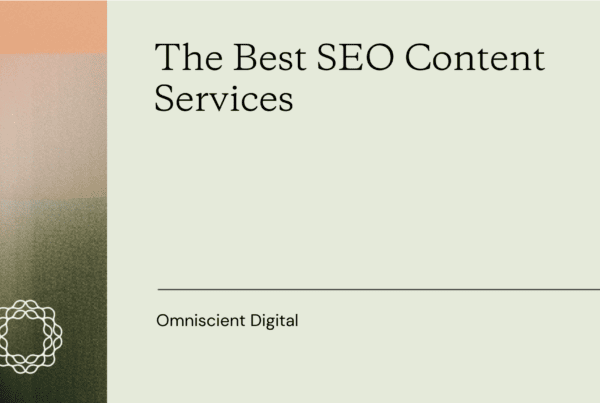
What is generative engine optimization (GEO)?
Well, it’s the forward ambulating foot, marching into the future of organic growth discovery.
In simpler terms, it’s the process of optimizing your brand, website, and content so that you increase your chances of being visible within AI engines like ChatGPT, Perplexity, Claude, AI Overviews, and anywhere else AI is transforming the customer journey.
Much of the fundamentals of good brand, product, and search engine marketing still apply here. However, on the margins, there are services and tactics that can help drive additional exposure, leads, and revenue from generative AI engines.
This list will feature a curated selection of the digital agencies I believe are best poised to drive real, measurable results through AI engines (as well as through traditional SEO).
The 8 Best Generative Engine Optimization Agencies in 2025
- Omniscient Digital
- iPullRank
- Growth Plays
- Quoleady
- OGM
- Flow Agency
- NoGood
- Skale
1. Omniscient Digital
Best for: Revenue-driving organic growth programs for B2B brands
Notable clients: SAP, Loom, Jasper, Hotjar, Asana, Adobe
Key services: SEO strategy, content production, digital PR, data-driven content, analytics and attribution
Omniscient Digital is the rare agency that blends editorial taste with performance rigor, beginning every engagement with an alignment on north star metrics and objectives that are meaningful to the business (not just vanity metrics).
Founded by a team of growth, SEO, and analytics practitioners, Omniscient’s differentiator lies in operationalizing Surround Sound SEO, a strategy developed during their time at HubSpot, focused on brand ubiquity, earning visibility across third-party lists, reviews, and content across the SERP and beyond. In a world increasingly mediated by AI engines (Perplexity, ChatGPT, AI Overviews), this kind of mention-level strategy translates directly into visibility and mindshare within AI summaries and conversational interfaces.
Beyond AI optimization, their holistic organic growth programs focus on full-funnel growth for B2B brands: SEO strategy that is built on buyer research, product and industry understanding, and SEO channel data. Content that is specific, useful, and centered around expertise, credibility, and conversion. Conversion optimization that constantly iterates, improves, and adds value to the busines.
They also bring a POV: content needs a reason to exist beyond search rankings. Clients like Asana, Loom, Jasper, and Hotjar partner with Omniscient not just for traffic but revenue outcomes, editorial polish, and boardroom-ready attribution.
2. iPullRank
Best for: Advanced technical SEO and early-stage AI adoption for enterprise-scale challenges
Notable clients: LG, DocSend, Citi
Key services: Audience research, technical SEO, generative AI, content strategy, content marketing
iPullRank is a technical SEO powerhouse that’s been ahead of the curve on AI integration.
Founded by Mike King, an engineer-turned-rapper-turned-SEO savant, the agency marries deep technical chops with creative execution. They’re the folks you call when your SEO problems span beyond “which keywords should I rank for?” and are headache-inducing fixes on the plumbing beneath the surface: JavaScript rendering, log file analysis, information architecture, structured data, and content engineering.
But iPullRank isn’t just for technical SEO in the classic sense. They’ve been exploring generative AI applications in content auditing, large-scale content production, and performance modeling before it became trendy.
3. Growth Plays
Best for: B2B SaaS companies looking to map SEO to revenue and get strategic content positioning right
Notable clients: Lattice, Heap, Calendly
Key services: SEO strategy, analytics, content strategy, CMS migrations,
Growth Plays sits at the intersection of SEO, go-to-market strategy, and sales enablement.
Founded by JH Scherck, the team has become known for building practical, ROI-focused SEO roadmaps that prioritize bottom-line impact over vanity metrics. If your team is tired of traffic that doesn’t convert, Growth Plays is the antidote.
They specialize in B2B SaaS, and they’re particularly great at technical products like developer tools, and frequently tackle complex sales cycles, aligning content with ICPs, buyer journeys, and revenue ops.
They really bring in some foundational business acumen, and their content audits go beyond “optimize this H1” into “kill this page, rewrite it for buyers, and map it to pipeline stages.”
More importantly, they’re keenly aware of AI’s reshaping of the search experience, helping clients audit, analyze, and improve their visibility in AI tools as well as classic search.
4. Quoleady
Best for: Growth-stage SaaS companies in search of scalable content and authority-building programs
Notable Clients: Monday.com, PandaDoc, GetVoiP, Expandi, Airfocus, Effy
Key services: SaaS content strategy, SEO for LLM visibility, SEO content writing, link building, content audits, analytics consulting,
Quoleady is a content and SEO agency focused on helping SaaS companies grow. They can work alongside your marketing team or handle everything on their own — from strategy to execution. Their work starts with strategy: identifying what to create, which keywords matter, and how to build authority with the right links. With a team of 35+ across 10+ countries, they take care of content and SEO so you don’t have to.
Their focus is exclusively B2B SaaS across IT, HR, finance, legal, marketing, education, and more. Quoleady works with growth-stage companies to build content engines that actually move the needle. They handle everything from SEO research and performance tracking to content production and outreach. A growing part of their work is LLMO (Large Language Model Optimization) – helping clients show up in AI tools like ChatGPT, Perplexity, Gemini, and beyond.
5. OGM
Best for: SEO strategy for high growth SaaS companies
Notable clients: Intercom, ShipBob, Ramp
Key services: SEO strategy, international SEO, content strategy
OGM, founded by Nigel Stevens, is a growth-focused SEO consultancy. Nigel and team have carved out a niche helping B2B startups and scaleups build high-leverage organic programs with minimal fluff. It’s the kind of shop where the founder actually runs your strategy calls and audits your sitemap.
What sets OGM apart is the prioritization discipline. Their programs start with strategic filtering: what’s worth investing in? Which SEO tactics are driving actual pipeline? And where does content intersect with the customer journey? They avoid the trap of “content for content’s sake” and build programs that serve both users and algorithms.
On the GEO front, OGM has already adapted playbooks for visibility across AI engines, whether that’s increasing citation surface area through smart guest contributions or building content that trains the answers AI tools serve.
6. Flow Agency
Best for: Integrated search engine marketing (paid and organic) for SaaS brands
Notable clients: Betterworks, MailCharts, ELM Learning
Key services: B2B SEO, paid media, GEO and LLM optimization, link building
Flow Agency (formerly Flow SEO) is a top tier SEO and SEM agency that focuses on SaaS companies.
In addition to being well versed in foundational PPC and search engine optimization best practices, Flow has been an early adopter of AI, both from a process and inputs perspective as well as optimizing for visibility in these engines.
Flow is definitely one of the top SaaS marketing agencies I know of, and they bring a flair of creativity that is uncommon in B2B marketing.
7. NoGood
Best for: Startups and scaleups that want SEO embedded into a broader growth experimentation framework
Notable clients: Intuit, Nike, Chime
Key services: Social ads, marketing analytics, video marketing, paid search, SEO, GEO
NoGood is a growth agency with a data-driven, full-funnel approach to marketing, blending paid, SEO, CRO, and analytics into an integrated growth engine. They’re a good fit for startups and scaleups looking to rapidly test and scale channels, with SEO playing one part of a broader system.
Their generative SEO work includes using AI to build scalable, programmatic content hubs, particularly for eCommerce, marketplaces, and consumer tech brands. They’re strong at turning market signals into executable content strategies, using structured data and experimentation to test content at volume.
Again, NoGood has been an early adopter in LLM optimization and AI visibility, constantly tinkering and even producing some original research on what signals correlate with visibility in these new surface areas.
8. Skale

Best for: SaaS and tech brands ready to win in the new era of search
Notable clients: HubSpot, Freshworks, MoonPay
Key services: SEO growth strategy, content production, link building, AI Search optimization
Skale partners with ambitious SaaS & tech brands to win across the entire search landscape. That means traditional Google rankings, but also presence in AI search engines like ChatGPT and Perplexity, YouTube, and traction in online communities where buying intent lives.
Their approach blends organic growth strategy, content marketing, technical SEO, and distribution. It’s not about publishing more blogs – it’s about building an organic engine that drives pipeline, retention, and ARR over time.
If your current SEO feels like busywork or doesn’t connect to growth, Skale helps you shift gears and build a system that compounds.
How to Choose an AI Optimization Partner
We’re in a weird moment. Generative engines are reshaping organic search. The rules are shifting, the tools are half-built, and everyone’s scrambling to keep up.
So how do you evaluate a partner in a landscape that’s still being defined?
You don’t look for certainty. You look for signal amidst the noise, and the strongest signal is intellectual honesty.
Below are a few core principles I use when assessing whether a GEO partner is worth trusting (or if they’re just trying to ride the AI hype wave).
1. Intellectual honesty
This is non-negotiable.
We’re still figuring this stuff out. There’s no proven blueprint for dominating AI Overviews or becoming the #1 cited brand in Perplexity. And anyone claiming otherwise is either selling a story or skipping the nuance (try not to spend too much time on LinkedIn).
The best partners aren’t making absolute claims or making you comment on their LinkedIn posts for the silver bullet secret. They’re showing you hypotheses, experiments, and early signals. They’ll tell you what they’ve tried. What failed. What they’re still testing. They’re skeptical of silver bullets, and they think in systems, not shortcuts.
They also know that this isn’t just about AI optimization or throwing all of your chips into LLMs, it’s about building defensible, holistic organic growth programs that will outlast short-term volatility.
If your agency isn’t willing to admit when they don’t know something, or worse, they’re selling “one weird trick” tactics—walk away.
2. Experience
This part’s obvious, but it’s still worth digging into: what have they actually done?
Not just who they’ve worked with, but the impact of those engagements. Have they run complex SEO programs tied to real outcomes, like net new revenue, product signups, or deal velocity? Can they speak clearly about how their work supported brand presence across both SERPs and third-party ecosystems?
You want a team that understands how to build across the full SEO stack—technical, editorial, off-page, strategic—but also how that work shows up in AI models. That requires more than just experience. It requires taste, pattern recognition, and a feedback loop that gets sharper with every client.
Ask for case studies. Ask what they’re proud of. Ask what didn’t work and what they learned. The good ones will be eager to talk about both.
3. Strategy over tactics
Good SEO partners have a system. Great ones tailor it to your business model, product, and customers.
A strong GEO strategy isn’t about cranking out blog posts or chasing AI traffic arbitrage. Those strategies tend to fall as fast as they grow. It’s about understanding your customer journey, identifying your points of leverage, and building an organic footprint that reinforces your brand everywhere people (and machines) look.
That means prioritizing based on opportunity size, content velocity, and strategic moats, not keyword difficulty scores alone. It also means understanding how content gets cited and surfaced across AI tools, and how to position your brand as the default answer in your category.
If the strategy is just “make skyscraper content, rank for keywords, build links,” it’s not a strategy. It’s a 2015 playbook repackaged for 2025.
4. Clear reporting and measurement
Vanity metrics are easy. AI visibility isn’t.
What matters is whether your agency can tie organic efforts, SEO or GEO, to business outcomes. That could mean sourced revenue, pipeline velocity, assisted conversions, or brand search volume. It could also mean more qualitative signals, like share of voice in third-party content, AI model citations, or earned visibility across digital touchpoints.
The key is that they’re tracking something meaningful and explaining why it matters.
Avoid anyone who’s still just sending you GA screenshots and traffic charts. Ask what they measure, how they model impact, and how they update their strategy based on data. If there’s no structured feedback loop, there’s no growth loop.
5. Cost structure
There’s a wide spectrum here.
Some GEO agencies charge enterprise retainers and work like a strategy consultancy. Others operate like a freelance collective with light overhead and à la carte pricing. Neither is inherently better. But you need to align cost with expectations, risk, and internal bandwidth.
Are you paying for raw output, or strategic oversight? Are they bringing a system, or just renting you time?
The better question is: what’s the cost of getting this wrong? If you’re optimizing for cheap, you’ll almost always end up with a long tail of low-leverage content and zero learnings. Good partners aren’t cheap, but they should compound over time. And they should be able to clearly articulate where the money is going and how it maps to outcomes.
Just don’t get caught in the trap of comparing price tags without understanding what’s underneath the hood.
6. Service capabilities
Before you get dazzled by claims of “AI-powered SEO” or clever automation tools, make sure the basics are covered.
Do they actually know SEO? Can they do technical audits, keyword research, content modeling, and structured data implementation? Do they have editorial chops, or are they farming it all out? Can they build content engines that work across human search and machine consumption?
GEO is an extension of your organic strategy. So the partner you choose should be able to connect the dots between AI visibility, traditional search, brand content, and conversion paths.
Look for teams that play across disciplines: technical, editorial, product, and growth. Because AI-generated answers don’t respect silos—and your organic strategy shouldn’t either.
Conclusion
Generative Engine Optimization is real. It’s happening. And it’s evolving faster than most marketers can react.
But that doesn’t mean the fundamentals go out the window. It means they matter more than ever.
You don’t need gimmicks. You don’t need hacks. You need a strategy rooted in experimentation, data, and structured thinking, a system that gets sharper with every iteration.
AI visibility is earned. It’s built on the back of clear positioning, smart content architecture, brand ubiquity, and technical integrity. It’s not a line item. It’s a layer that cuts across everything you publish and everything that represents you online.
At Omniscient Digital, this is the game we play. We’ve helped B2B brands build defensible, revenue-generating organic growth programs that show up across human and machine channels. And we’re still learning every week—testing, shipping, adjusting.
If you’re serious about not just being found, but being cited—not just ranking, but resonating—we should talk.


